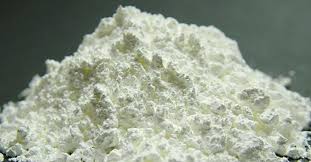Dysprosium oxide (chemical formula Dy₂O₃) is a compound composed of dysprosium and oxygen. The following is a detailed introduction to dysprosium oxide:
Chemical properties
Appearance: white crystalline powder.
Solubility: insoluble in water, but soluble in acid and ethanol.
Magnetism: has strong magnetism.
Stability: easily absorbs carbon dioxide in the air and partially turns into dysprosium carbonate.

Brief introduction
| Product name | Dysprosium oxide |
| Cas no | 1308-87-8 |
| Purity | 2N 5(Dy2O3/REO≥ 99.5%)3N (Dy2O3/REO≥ 99.9%)4N (Dy2O3/REO≥ 99.99%) |
| MF | Dy2O3 |
| Molecular Weight | 373.00 |
| Density | 7.81 g/cm3 |
| Melting point | 2,408° C |
| Boiling point | 3900℃ |
| Appearance | White powder |
| Solubility | Insoluble in water, moderately soluble in strong mineral acids |
| Multilingual | DysprosiumOxid, Oxyde De Dysprosium, Oxido Del Disprosio |
| Other name | Dysprosium(III) oxide,Dysprosia |
| HS code | 2846901500 |
| Brand | Epoch |
Preparation method
There are many methods for preparing dysprosium oxide, among which the most common are chemical method and physical method. The chemical method mainly includes oxidation method and precipitation method. Both methods involve chemical reaction process. By controlling the reaction conditions and the ratio of raw materials, dysprosium oxide with high purity can be obtained. The physical method mainly includes vacuum evaporation method and sputtering method, which are suitable for preparing high-purity dysprosium oxide films or coatings.
In the chemical method, oxidation method is one of the most commonly used preparation methods. It generates dysprosium oxide by reacting dysprosium metal or dysprosium salt with an oxidant. This method is simple and easy to operate, and low in cost, but harmful gases and wastewater may be generated during the preparation process, which need to be properly handled. The precipitation method is to react the dysprosium salt solution with the precipitant to generate a precipitate, and then obtain dysprosium oxide through filtering, washing, drying and other steps. The dysprosium oxide prepared by this method has a higher purity, but the preparation process is more complicated.
In the physical method, vacuum evaporation method and sputtering method are both effective methods for preparing high-purity dysprosium oxide films or coatings. The vacuum evaporation method is to heat the dysprosium source under vacuum conditions to evaporate it and deposit it on the substrate to form a thin film. The film prepared by this method has high purity and good quality, but the equipment cost is high. The sputtering method uses high-energy particles to bombard the dysprosium target material, so that the surface atoms are sputtered out and deposited on the substrate to form a thin film. The film prepared by this method has good uniformity and strong adhesion, but the preparation process is more complicated.
Use
Dysprosium oxide has a wide range of application scenarios, mainly including the following aspects:
Magnetic materials: Dysprosium oxide can be used to prepare giant magnetostrictive alloys (such as terbium dysprosium iron alloy), as well as magnetic storage media, etc.
Nuclear industry: Due to its large neutron capture cross-section, dysprosium oxide can be used to measure neutron energy spectrum or as a neutron absorber in nuclear reactor control materials.
Lighting field: Dysprosium oxide is an important raw material for manufacturing new light source dysprosium lamps. Dysprosium lamps have the characteristics of high brightness, high color temperature, small size, stable arc, etc., and are widely used in film and television creation and industrial lighting.
Other applications: Dysprosium oxide can also be used as a phosphor activator, NdFeB permanent magnet additive, laser crystal, etc.
Market situation
My country is a major producer and exporter of dysprosium oxide. With the continuous optimization of the preparation process, the production of dysprosium oxide is developing in the direction of nano-, ultra-fine, high-purification, and environmental protection.
Safety
Dysprosium oxide is usually packaged in double-layer polyethylene plastic bags with hot-pressing sealing, protected by outer cartons, and stored in ventilated and dry warehouses. During storage and transportation, attention should be paid to moisture-proof and avoid packaging damage.

How is nano-dysprosium oxide different from traditional dysprosium oxide?
Compared with traditional dysprosium oxide, nano-dysprosium oxide has significant differences in physical, chemical and application properties, which are mainly reflected in the following aspects:
1. Particle size and specific surface area
Nano-dysprosium oxide: The particle size is usually between 1-100 nanometers, with extremely high specific surface area (for example, 30m²/g), high surface atomic ratio, and strong surface activity.
Traditional dysprosium oxide: The particle size is larger, usually at the micron level, with a smaller specific surface area and lower surface activity.
2. Physical properties
Optical properties: Nano-dysprosium oxide: It has a higher refractive index and reflectivity, and exhibits excellent optical properties. It can be used in optical sensors, spectrometers and other fields.
Traditional dysprosium oxide: The optical properties are mainly reflected in its high refractive index and low scattering loss, but it is not as outstanding as nano-dysprosium oxide in optical applications.
Magnetic properties: Nano-dysprosium oxide: Due to its high specific surface area and surface activity, nano-dysprosium oxide exhibits higher magnetic responsiveness and selectivity in magnetism, and can be used for high-resolution magnetic imaging and magnetic storage.
Traditional dysprosium oxide: has strong magnetism, but the magnetic response is not as significant as that of nano dysprosium oxide.
3. Chemical properties
Reactivity: Nano dysprosium oxide: has higher chemical reactivity, can more effectively adsorb reactant molecules and accelerate the chemical reaction rate, so it shows higher activity in catalysis and chemical reactions.
Traditional dysprosium oxide: has high chemical stability and relatively low reactivity.
4. Application areas
Nano dysprosium oxide: Used in magnetic materials such as magnetic storage and magnetic separators.
In the optical field, it can be used for high-precision equipment such as lasers and sensors.
As an additive for high-performance NdFeB permanent magnets.
Traditional dysprosium oxide: Mainly used to prepare metallic dysprosium, glass additives, magneto-optical memory materials, etc.
5. Preparation method
Nano dysprosium oxide: usually prepared by solvothermal method, alkali solvent method and other technologies, which can accurately control the particle size and morphology.
Traditional dysprosium oxide: mostly prepared by chemical methods (such as oxidation method, precipitation method) or physical methods (such as vacuum evaporation method, sputtering method)
Post time: Jan-20-2025